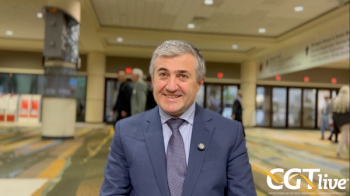
Targeting Unmet Needs in Rare Dermatologic Diseases With Gene Therapy
Matthew Gantz, president and chief executive officer, Castle Creek Biosciences, discussed FCX-013 for the potential treatment of scleroderma.
“Patients with recessive dystrophic EB... from day 1, they need to have constant wound care and are bandaged repeatedly... they have repeated healing and scarring, they lose functionality of their hands, they end up becoming wheelchair bound, and unfortunately, many of them can succumb to squamous cell carcinoma, so they die young. And the cost of wound care is exorbitant... There's a significant unmet need. Any therapy that can reduce the burden of disease and help these wounds heal quicker, so that these patients can live more of a normal life and have a better quality of life is going to be huge.”
Castle Creek Biosciences is developing cell and gene therapies for rare diseases, with their lead candidates in rare dermatologic diseases and new candidates in rare metabolic and liver diseases following the acquisition of Novavita Thera.1 The company uses a dual cell and gene therapy platform to use lentiviral vectors in both the in vivo and ex vivo setting.
Dabocemagene autoficel (FCX-007, D-Fi), Castle Creek’s lead program, is a gene therapy for the potential treatment of recessive dystrophic epidermolysis bullosa (RDEB). D-Fi is currently being assessed in a phase 3 trial (NCT04213261) and was awarded an Orphan Products Development Grant in late 2021.2
CGTLive spoke with Matthew Gantz, president and chief executive officer, Castle Creek, to learn more about the indications they are targeting, including an earlier-stage candidate in scleroderma. He also discussed unmet needs in RDEB and the importance of collaborating with patient advocacy groups.
REFERENCES
1. Castle Creek Biosciences acquires Novavita Thera to expand innovative cell and gene therapy platform. News release. Castle Creek Biosciences. January 10, 2022. https://castlecreekbio.com/castle-creek-biosciences-acquires-novavita-thera-to-expand-innovative-cell-and-gene-therapy-platform/
2. Castle Creek Biosciences awarded FDA orphan products development grant to support DeFi-RDEB, a pivotal phase 3 study of FCX-007 investigational gene therapy for recessive dystrophic epidermolysis bullosa. News release. Castle Creek Biosciences. October 21, 2021. https://castlecreekbio.com/castle-creek-biosciences-awarded-fda-orphan-products-development-grant-to-support-defi-rdeb-a-pivotal-phase-3-study-of-fcx-007-investigational-gene-therapy-for-recessive-dystrophic-epidermolysis-bull/
Newsletter
Stay at the forefront of cutting-edge science with CGT—your direct line to expert insights, breakthrough data, and real-time coverage of the latest advancements in cell and gene therapy.

















































